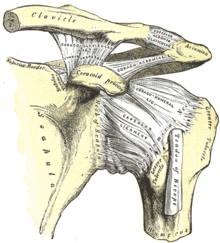| This article includes a list of references, related reading, or external links, but its sources remain unclear because it lacks inline citations. Please help improve this article by introducing more precise citations. (October 2011) (Learn how and when to remove this message) |
| Perthes lesion | |
|---|---|
 | |
| Glenohumeral |
Perthes lesion is a variant of Bankart lesion, presenting as an anterior glenohumeral injury that occurs when the scapular periosteum remains intact but is stripped medially and the anterior labrum is avulsed from the glenoid but remains partially attached to the scapula by intact periosteum.
Signs and symptoms
| This section is empty. You can help by adding to it. (February 2023) |
Cause
| This section is empty. You can help by adding to it. (November 2017) |
Diagnosis
The lesion is associated with any damage to the antero-inferior labrum. Most commonly due to anterior shoulder dislocation. The lesion often occurs after the initial dislocation. In chronic cases, there may be fibrosis and resynovialization of the labrum and periosteum.
The lesion is best identified on MR arthrography. Additional views in ABER (ABduction and External Rotation) of the shoulder aid in this diagnosis.
Differential diagnoses include:
- Bankart lesion
- Alpsa lesion
- GLAD
- HAGL
- BHAGL
Treatment
Treatment is surgical re-attachment of the labrum preferably via arthroscopy.
Eponym
It is named after Georg C. Perthes (1869-1927), a German Surgeon and X-Ray diagnostic pioneer who first described the lesion in 1905.
References
1. Perthes Lesion (A Variant of the Bankart Lesion): MR Imaging and MR Arthrographic Findings with Surgical Correlation Thorsten K. Wischer, Miriam A. Bredella, Harry K. Genant, David W. Stoller, Frederic W. Bost, and Phillip F. J. Tirman AJR January 2002 178:233-237
2. MRI of the shoulder By Michael B. Zlatkin, Lippincott, Williams and Wilkins 2003
Categories: